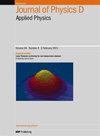厚介电材料中的二次电子发射率:开尔文探针法与电容法的比较
IF 3.2
3区 物理与天体物理
Q2 PHYSICS, APPLIED
引用次数: 0
摘要
近年来,航天工业对电介质材料二次电子发射率(SEY)测量的需求很大,这促使 SEY 实验室不断改进其设施和测量技术。采用普通电容法(也称为脉冲法)测定 SEY 已被广泛接受,在大多数情况下都能获得令人满意的结果。不过,所研究的样品必须根据该技术的实验限制进行制备,即样品应在制造过程中与设备分离,如实反映设备本身的表面状态,并尽可能薄。本文提出了一种基于开尔文探针 (KP) 的方法,用于获得放置在厚度为 1.6 至 12.1 毫米的介电间隔上的电浮动铂、Kapton 和聚四氟乙烯的 SEY 特性。结果与电容法进行了比较,表明 KP SEY 曲线对间隔物厚度的敏感性较低。我们还给出了基于文献的解释。总之,我们已经确定 KP 更适合分析厚度大于 3 毫米的介质样品。本文章由计算机程序翻译,如有差异,请以英文原文为准。
Secondary electron emission yield in thick dielectric materials: a comparison between Kelvin probe and capacitive methods
The recent high demand of secondary electron emission yield (SEY) measurements in dielectric materials from space industry has driven SEY laboratories to improve their facilities and measurement techniques. SEY determination by the common capacitive method, also known as pulsed method, is well accepted and has given satisfactory results in most cases. Nevertheless, the samples under study must be prepared according to the experimental limitations of the technique, i.e. they should be manufactured separated from the devices representing faithfully the surface state of the own device and be as thin as possible. A method based on the Kelvin probe (KP) is proposed here to obtain the SEY characteristics of electrically floating Platinum, Kapton and Teflon placed over dielectric spacers with thicknesses ranging from 1.6 to 12.1 mm. The results are compared with those of the capacitive method and indicate that KP SEY curves are less sensitive to spacer thickness. An explanation based on the literature is also given. In all, we have established that KP is better suited for the analysis of dielectric samples thicker than 3 mm.
求助全文
通过发布文献求助,成功后即可免费获取论文全文。
去求助
来源期刊
CiteScore
6.80
自引率
8.80%
发文量
835
审稿时长
2.1 months
期刊介绍:
This journal is concerned with all aspects of applied physics research, from biophysics, magnetism, plasmas and semiconductors to the structure and properties of matter.

 求助内容:
求助内容: 应助结果提醒方式:
应助结果提醒方式:


